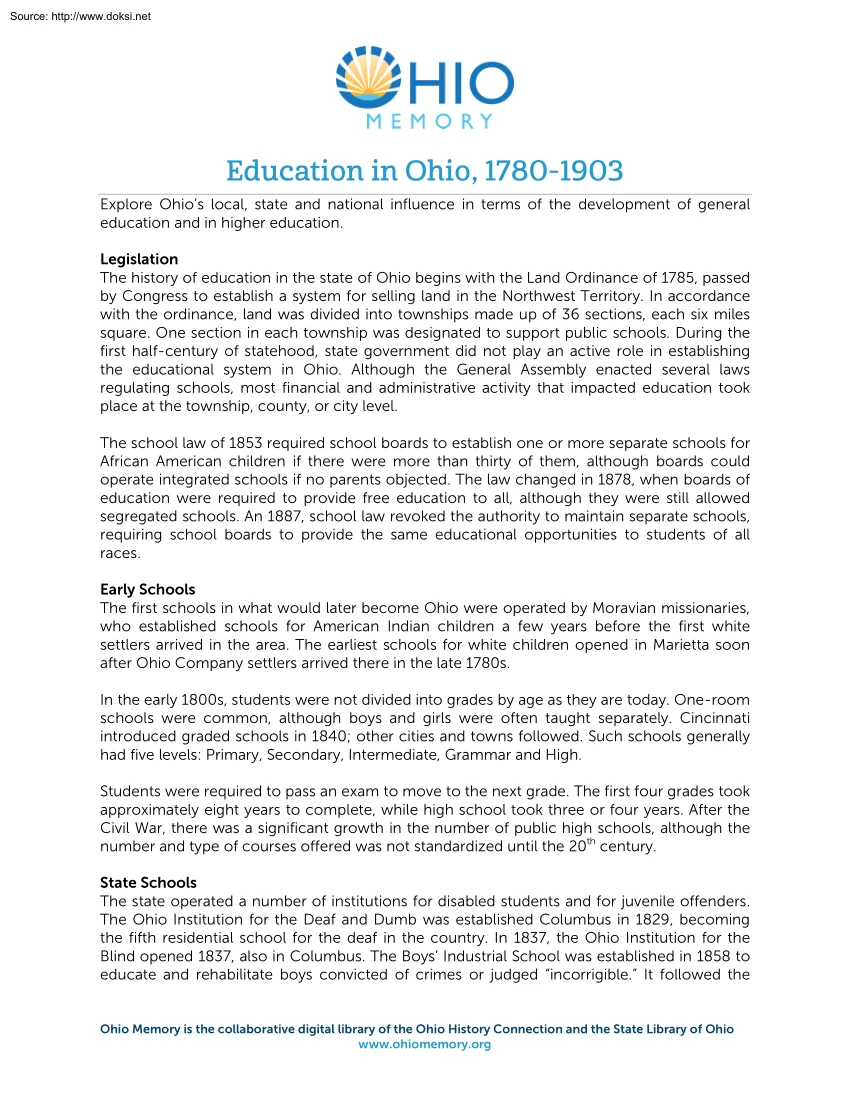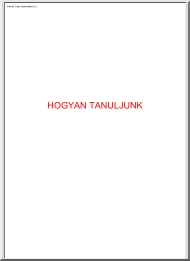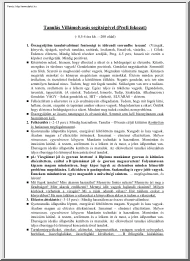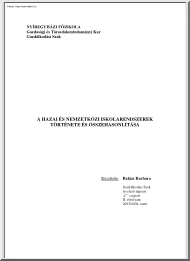Datasheet
Year, pagecount:2014, 3 page(s)
Language:English
Downloads:2
Uploaded:September 03, 2018
Size:535 KB
Institution:
-
Comments:
Attachment:-
Download in PDF:Please log in!
Comments
No comments yet. You can be the first!Content extract
Source: http://www.doksinet Education in Ohio, 1780-1903 Explore Ohio’s local, state and national influence in terms of the development of general education and in higher education. Legislation The history of education in the state of Ohio begins with the Land Ordinance of 1785, passed by Congress to establish a system for selling land in the Northwest Territory. In accordance with the ordinance, land was divided into townships made up of 36 sections, each six miles square. One section in each township was designated to support public schools During the first half-century of statehood, state government did not play an active role in establishing the educational system in Ohio. Although the General Assembly enacted several laws regulating schools, most financial and administrative activity that impacted education took place at the township, county, or city level. The school law of 1853 required school boards to establish one or more separate schools for African American children if
there were more than thirty of them, although boards could operate integrated schools if no parents objected. The law changed in 1878, when boards of education were required to provide free education to all, although they were still allowed segregated schools. An 1887, school law revoked the authority to maintain separate schools, requiring school boards to provide the same educational opportunities to students of all races. Early Schools The first schools in what would later become Ohio were operated by Moravian missionaries, who established schools for American Indian children a few years before the first white settlers arrived in the area. The earliest schools for white children opened in Marietta soon after Ohio Company settlers arrived there in the late 1780s. In the early 1800s, students were not divided into grades by age as they are today. One-room schools were common, although boys and girls were often taught separately. Cincinnati introduced graded schools in 1840; other
cities and towns followed. Such schools generally had five levels: Primary, Secondary, Intermediate, Grammar and High. Students were required to pass an exam to move to the next grade. The first four grades took approximately eight years to complete, while high school took three or four years. After the Civil War, there was a significant growth in the number of public high schools, although the number and type of courses offered was not standardized until the 20th century. State Schools The state operated a number of institutions for disabled students and for juvenile offenders. The Ohio Institution for the Deaf and Dumb was established Columbus in 1829, becoming the fifth residential school for the deaf in the country. In 1837, the Ohio Institution for the Blind opened 1837, also in Columbus. The Boys’ Industrial School was established in 1858 to educate and rehabilitate boys convicted of crimes or judged “incorrigible.” It followed the Ohio Memory is the collaborative digital
library of the Ohio History Connection and the State Library of Ohio www.ohiomemoryorg Source: http://www.doksinet cottage system, in which forty boys lived together in a cottage, worked together doing farm chores, and learned skilled trades. The Girls’ Industrial School in White Sulphur Springs, near Delaware, was organized in a similar fashion in 1869. Teacher Training and Certification Early 19th century teachers were certified by a local or county board of examiners. They were required to pass a test proving their competence to teach reading, writing, and arithmetic. Geography, grammar, and orthography (spelling) were later added to required subjects. Examiners also judged the “moral character” of teachers. In 1864, a state board of examiners began issuing certificates accepted in all parts of the state. Normal schools, which trained teachers, became increasingly important as the certification process became more rigorous. Early normal schools were privately funded They
included McNeely Normal School (Green Township, Harrison County), Normal School of Ohio (Lebanon), and Western Reserve Normal School (Milan), all established in the 1850s. In later years, other schools were established throughout the state. Eventually colleges and universities took the place of normal schools. Higher Education The first institution of higher education established in the state was Ohio University in Athens, on Ohio Company land. It received its charter in 1804 Miami University in Oxford, Ohio, established in 1824, was the second school. Between 1803 and 1860, there were 14 universities and 42 colleges chartered in the state, including: Western Reserve University (1826) Kenyon College (1828) Capital University (1830) Denison University (1831) Marietta College (1835) Ohio Wesleyan University (1842) St. Francis Xavier University (1842) Wittenberg University (1845) Otterbein College (1849) Heidelberg
College (1850) Hiram College (1850) Lake Erie College (1856) College of Wooster (1866) University of Akron (1870) University of Cincinnati (1870) University of Toledo (1872) Ashland University (1878) Many schools were affiliated with Christian denominations and had separate seminaries for women, although Oberlin College (1833) and Antioch University (1852) were co-educational and open to African American students. Other notable institutions are Central State University Ohio Memory is the collaborative digital library of the Ohio History Connection and the State Library of Ohio www.ohiomemoryorg Source: http://www.doksinet (1856) and Wilberforce University (1856), which were established to provide African Americans with educational opportunities. In 1862, Congress gave each state land for the endowment of an agricultural and mechanical college. Sale of the land created the endowment that allowed for the establishment of Ohio Agricultural and Mechanical College in 1870. In 1878, the
institution became known as the Ohio State University. Notable People Albert Belmont Graham (1868-1960): An Ohio native, teacher, and school administrator, Graham started the 4-H organization in Springfield, Ohio, in 1902. The name refers to the head, heart, hands, and health. Through the organization, which is still active today, boys and girls learn by doing, particularly through agricultural experimentation. William Holmes McGuffey (1800-1873): A professor at Miami University and president of Cincinnati College and Ohio University, McGuffey created the McGuffey Reader text books, first published in 1836 and widely used until the early 20th century. Platt Spencer (1800-1864): A Geneva, Ohio, resident who developed the Spencerian handwriting system, the most widely-used teaching method in the 19th century. Horace Mann (1796-1859): A Massachusetts-born lawyer, state legislator, and proponent of educational reform and teacher training, Mann became the first president of Antioch College,
a co-educational, racially integrated, non-sectarian school, where he also taught philosophy and theology. Bibliography Burns, James J. Educational History of Ohio: A History of its Progress since the Formation of the State Together with the Portraits and Biographies of Past and Present State Officials. Columbus: Historical Publishing Co., 1905 Dunn, W. Ross “Education in Territorial Ohio” Ohio Archaeological and Historical Society Publications 35 (1926): 322-379. A History of Education in the State of Ohio: A Centennial Volume Published by Authority of the General Assembly. Columbus: Gazette Printing House, 1876 Knepper, George W. Ohio and Its People Kent: Kent State University Press, 1989 Knepper, George W. An Ohio Portrait Columbus: Ohio Historical Society, 1976 McAlpine, William. “The Origin of Public Education in Ohio” Ohio Archaeological and Historical Society Publications 38 (1929): 409-447. Roseboom, Eugene H. and Francis P Weisenburger A History of Ohio Columbus: Ohio
Historical Society, 1991. Ohio Memory is the collaborative digital library of the Ohio History Connection and the State Library of Ohio www.ohiomemoryorg
there were more than thirty of them, although boards could operate integrated schools if no parents objected. The law changed in 1878, when boards of education were required to provide free education to all, although they were still allowed segregated schools. An 1887, school law revoked the authority to maintain separate schools, requiring school boards to provide the same educational opportunities to students of all races. Early Schools The first schools in what would later become Ohio were operated by Moravian missionaries, who established schools for American Indian children a few years before the first white settlers arrived in the area. The earliest schools for white children opened in Marietta soon after Ohio Company settlers arrived there in the late 1780s. In the early 1800s, students were not divided into grades by age as they are today. One-room schools were common, although boys and girls were often taught separately. Cincinnati introduced graded schools in 1840; other
cities and towns followed. Such schools generally had five levels: Primary, Secondary, Intermediate, Grammar and High. Students were required to pass an exam to move to the next grade. The first four grades took approximately eight years to complete, while high school took three or four years. After the Civil War, there was a significant growth in the number of public high schools, although the number and type of courses offered was not standardized until the 20th century. State Schools The state operated a number of institutions for disabled students and for juvenile offenders. The Ohio Institution for the Deaf and Dumb was established Columbus in 1829, becoming the fifth residential school for the deaf in the country. In 1837, the Ohio Institution for the Blind opened 1837, also in Columbus. The Boys’ Industrial School was established in 1858 to educate and rehabilitate boys convicted of crimes or judged “incorrigible.” It followed the Ohio Memory is the collaborative digital
library of the Ohio History Connection and the State Library of Ohio www.ohiomemoryorg Source: http://www.doksinet cottage system, in which forty boys lived together in a cottage, worked together doing farm chores, and learned skilled trades. The Girls’ Industrial School in White Sulphur Springs, near Delaware, was organized in a similar fashion in 1869. Teacher Training and Certification Early 19th century teachers were certified by a local or county board of examiners. They were required to pass a test proving their competence to teach reading, writing, and arithmetic. Geography, grammar, and orthography (spelling) were later added to required subjects. Examiners also judged the “moral character” of teachers. In 1864, a state board of examiners began issuing certificates accepted in all parts of the state. Normal schools, which trained teachers, became increasingly important as the certification process became more rigorous. Early normal schools were privately funded They
included McNeely Normal School (Green Township, Harrison County), Normal School of Ohio (Lebanon), and Western Reserve Normal School (Milan), all established in the 1850s. In later years, other schools were established throughout the state. Eventually colleges and universities took the place of normal schools. Higher Education The first institution of higher education established in the state was Ohio University in Athens, on Ohio Company land. It received its charter in 1804 Miami University in Oxford, Ohio, established in 1824, was the second school. Between 1803 and 1860, there were 14 universities and 42 colleges chartered in the state, including: Western Reserve University (1826) Kenyon College (1828) Capital University (1830) Denison University (1831) Marietta College (1835) Ohio Wesleyan University (1842) St. Francis Xavier University (1842) Wittenberg University (1845) Otterbein College (1849) Heidelberg
College (1850) Hiram College (1850) Lake Erie College (1856) College of Wooster (1866) University of Akron (1870) University of Cincinnati (1870) University of Toledo (1872) Ashland University (1878) Many schools were affiliated with Christian denominations and had separate seminaries for women, although Oberlin College (1833) and Antioch University (1852) were co-educational and open to African American students. Other notable institutions are Central State University Ohio Memory is the collaborative digital library of the Ohio History Connection and the State Library of Ohio www.ohiomemoryorg Source: http://www.doksinet (1856) and Wilberforce University (1856), which were established to provide African Americans with educational opportunities. In 1862, Congress gave each state land for the endowment of an agricultural and mechanical college. Sale of the land created the endowment that allowed for the establishment of Ohio Agricultural and Mechanical College in 1870. In 1878, the
institution became known as the Ohio State University. Notable People Albert Belmont Graham (1868-1960): An Ohio native, teacher, and school administrator, Graham started the 4-H organization in Springfield, Ohio, in 1902. The name refers to the head, heart, hands, and health. Through the organization, which is still active today, boys and girls learn by doing, particularly through agricultural experimentation. William Holmes McGuffey (1800-1873): A professor at Miami University and president of Cincinnati College and Ohio University, McGuffey created the McGuffey Reader text books, first published in 1836 and widely used until the early 20th century. Platt Spencer (1800-1864): A Geneva, Ohio, resident who developed the Spencerian handwriting system, the most widely-used teaching method in the 19th century. Horace Mann (1796-1859): A Massachusetts-born lawyer, state legislator, and proponent of educational reform and teacher training, Mann became the first president of Antioch College,
a co-educational, racially integrated, non-sectarian school, where he also taught philosophy and theology. Bibliography Burns, James J. Educational History of Ohio: A History of its Progress since the Formation of the State Together with the Portraits and Biographies of Past and Present State Officials. Columbus: Historical Publishing Co., 1905 Dunn, W. Ross “Education in Territorial Ohio” Ohio Archaeological and Historical Society Publications 35 (1926): 322-379. A History of Education in the State of Ohio: A Centennial Volume Published by Authority of the General Assembly. Columbus: Gazette Printing House, 1876 Knepper, George W. Ohio and Its People Kent: Kent State University Press, 1989 Knepper, George W. An Ohio Portrait Columbus: Ohio Historical Society, 1976 McAlpine, William. “The Origin of Public Education in Ohio” Ohio Archaeological and Historical Society Publications 38 (1929): 409-447. Roseboom, Eugene H. and Francis P Weisenburger A History of Ohio Columbus: Ohio
Historical Society, 1991. Ohio Memory is the collaborative digital library of the Ohio History Connection and the State Library of Ohio www.ohiomemoryorg





 When reading, most of us just let a story wash over us, getting lost in the world of the book rather than paying attention to the individual elements of the plot or writing. However, in English class, our teachers ask us to look at the mechanics of the writing.
When reading, most of us just let a story wash over us, getting lost in the world of the book rather than paying attention to the individual elements of the plot or writing. However, in English class, our teachers ask us to look at the mechanics of the writing.